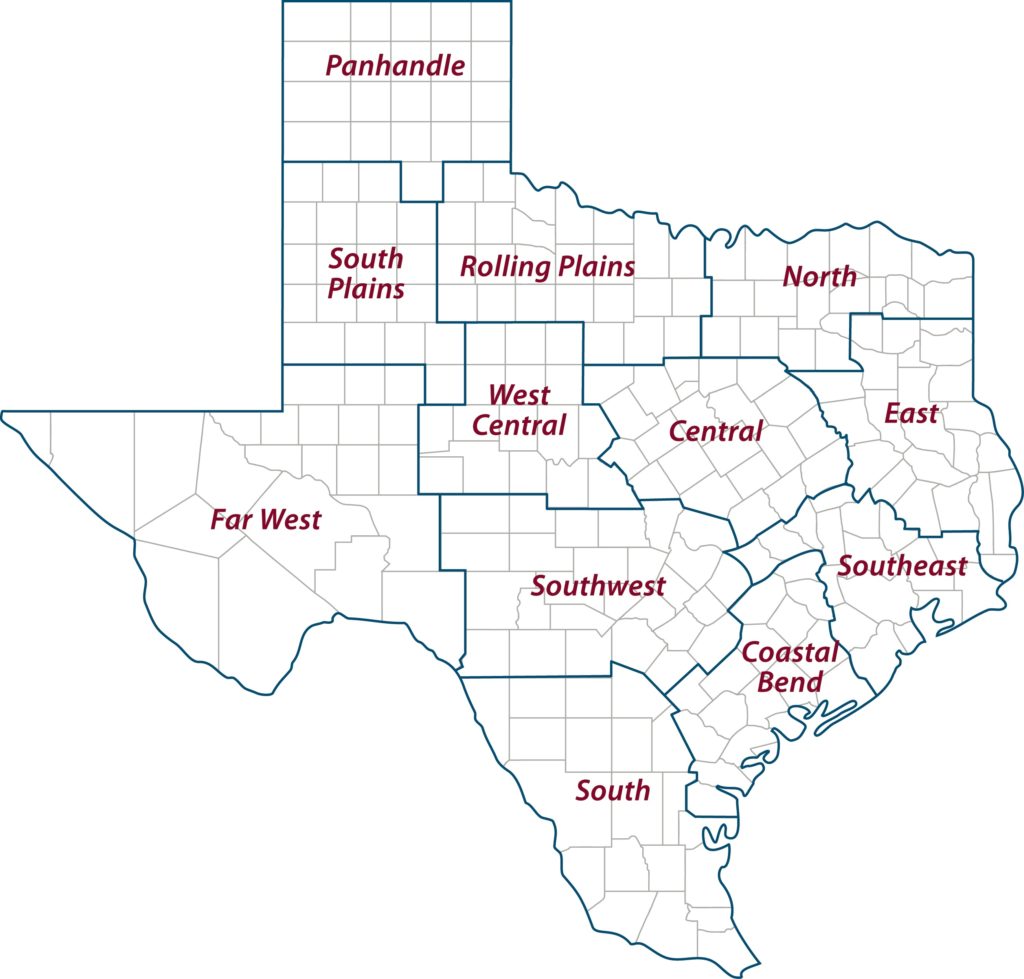- South Texas Students Meet Accordion Music Icons Los Tigres Del Norte In Edinburg Thanks To Khs America/Hohner Alianza Académica Initiative
- Fragile Planet Offers a Nighttime Wildlife Experience
- Falcons Soccer Off & Running
- Cameron County Receives Funds to Improve Two Parks
- Falcons Complete First Half of 32-6A
- School District to Help out Victims of California Wildfires
- Sand Castle Days Continued Despite Unexpected Weather
- Ready for District
- Discussion of Garbage Dumpster Rates, Agreements Between State & City on Highway Regulations, and More
- 31st Annual Shrimp Cook-Off is Right Around the Corner
Dry Spell, Drought Deepens Across Texas
- Updated: April 1, 2022

Texas Crop and Weather Report – March 8, 2022
Written by Adam Russell
Soil moisture levels continue to decline in most areas of the state after a months-long dry spell as warm-season crop plantings and preparations increase.
Texas A&M AgriLife Extension Service agents and specialists have reported critically dry conditions in many parts of the state over the last several weeks. The U.S. Drought Monitor shows more than 93% of the state is in abnormally dry to extreme drought and nearly 81% of the state dealing with moderate-to-extreme drought.
Plantings and fieldwork that require rainfall are being delayed in the hopes that moisture will arrive sooner than later. Cool-season forage and grain crops were failing in some parts of the state, or in poor condition and progressing slowly due to lack of moisture.
The lack of forage and dependence on heavy supplemental feed rations was driving deeper and deeper herd culls for cattle producers in some areas.
“It is very, very dry,” said Jourdan Bell, Ph.D., AgriLife Extension agronomist, Amarillo. “There is no surface moisture and very few fields have subsoil moisture. We have had negligible moisture this winter.”
Most of the Panhandle is experiencing extreme drought, according to the drought monitor.
Historic winter dry spell
John Nielsen-Gammon, Ph.D., state climatologist in the College of Geosciences Department of Atmospheric Sciences at Texas A&M University, said much of the state has been very dry since fall and the rain outlook does not look promising.
Over the past 120 days, Nielsen-Gammon said much of the state had only received 25% of its average rainfall for that period. Several cities also reported some of the driest periods between November and March on record.
Amarillo reported 0.5 inches of rainfall during that time, which represents the fourth-driest winter over the past 131 years. There was a drier stretch during the same time in 2017-2018.
Midland experienced the fifth-driest period on record with 0.3 of an inch and Waco was the third driest in 121-years with 2.94 inches of rainfall.
Cities like Houston and Beaumont received much more rain, but it was still the driest spell between November and March on record for Beaumont with 5.81 inches.
“Dry is relative in Texas,” he said. “A few swaths of the state have done OK, but most of the state has been dry since the widespread spring and summer rains ended last August.”
La Niña continues
Nielsen-Gammon said the La Niña weather system, which typically delivers below-average precipitation to much of Texas, continues to hang on. Most forecast models expect the La Niña system to enter a neutral period by April.
But by April, weather in Texas is becoming difficult to forecast beyond a week to 10 days. Expectations for April through June are that the state will receive below-normal rainfall, but Nielsen-Gammon said the same was expected last April through June prior to the widespread and consistent rains.
He said this week and next do not look promising for most of the state either. Much of the state will not see much moisture. In East Texas, expectations are for scattered, mostly light rains, though a cold front later in the week could help maintain soil moisture.
“There are a few storm systems coming through, but it doesn’t look promising for most of the state,” he said. “After that, it’s hard to tell.”
AgriLife Extension district reporters compiled the following summaries:
CENTRAL
Dry conditions persisted. More than half the district reported short soil moisture levels. Warmer temperatures were in the forecast. Winter wheat and oats were not maturing or growing well due to drought. Corn planting has now begun under generally good soil moisture conditions. Some producers were booking cotton prices at over $1 per pound. The prediction for a drier weather pattern and stronger cotton prices may shift some acres away from corn. Livestock were in good condition and stock tank levels were adequate. Overall livestock conditions were fair.
ROLLING PLAINS
Conditions were very dry. A fire last week consumed 818 acres of grazing land. Most wheat was being grazed out. The soil profile received some moisture from an ice storm, which allowed some wheat to green up, but there were still several dead patches in fields. Most wheat was in poor to very poor condition. Heavy supplemental feeding continued for cattle on rangelands. Forage inventories continued to decline. Row crop tillage delays continued due to lack of moisture for proper tillage. Some producers spread fertilizer with chances of rain in the forecast, but moisture did not materialize.
COASTAL BEND
Days were warm with high winds and low humidity. The drying weather allowed producers to get into fields to plant corn, sorghum and rice. Soil moisture was short and beginning to be a concern. Sorghum producers were having to plant deeper than normal to find moisture. Winter pastures needed significant rainfall to finish grazing and grain crops. Most hay producers were waiting to fertilize hay fields until there was increased soil moisture. Livestock were showing signs of declining body condition and were still being fed hay and protein. Spring calving season began.
EAST
The district remained in desperate need of rainfall. Subsoil and topsoil conditions ranged from short to adequate. High winds dried out any recent moisture received. Houston County reported extremely high fire danger. Ponds and creeks remained low. Cool-season forages continued to be far below normal production due to dry conditions. Pasture and rangeland conditions varied from very poor to good in some areas. The cattle market remained steady to slightly better. Livestock were doing fair to good with supplemental feeding. Producers were concerned about high fertilizer costs and its effect on hay production. Wild pig activity increased with damages to pastures and cropland.
SOUTH PLAINS
Extremely dry conditions persisted in the district. Producers with triticale and wheat began to water those crops, which were behind in maturation due to the lack of moisture. Producers were limiting top-dressing fertilizer. Planting conditions were unfavorable moving into the main growing season. Preplant irrigation was occurring but was sporadic. Cattle producers were supplementing herds with feedstuffs and hay.
PANHANDLE
Dry, warm conditions persisted. All counties reported very short to short soil moisture. Dryland wheat was in gradual decline. Irrigated wheat was receiving water. Summer crop preplant fieldwork continued. Cattle were receiving supplemental feed on rangeland. Crops, rangeland and pastures were in very poor to poor condition.
NORTH
Soil moisture ranged from short to adequate. Dry warm weather continued. Rains helped, but more was needed. Temperatures in some areas reached the mid- to upper-70s. Oats were generally in fair to good condition with a few counties reporting poor conditions. Winter wheat looked better after some fertilizer, moisture and sunshine; most fields were in poor to good condition. Pasture and rangeland conditions were very poor to fair. Hay was expected to be more expensive with Sudan round bales needing to clear $90 per bale to cover production costs.
FAR WEST
Temperatures were in the mid-60s during the day with lows in the high- to low-30s at night. Conditions were dry with no rainfall. The district went 200 days since the last rain of 0.5 of an inch or more. There was no wheat, and pastures were bare. A few growers turned on their irrigation wells. Irrigated acres may be down considerably this year, especially considering the high cost of inputs. Summer forages were still dormant. Producers were supplementing all livestock with hay and grain. Ranchers were selling more cattle weekly including breeding stock. Area ranchers continued to prepare for spring branding season, which generally begins in March. Major producers were getting ready for their annual bull sale, rotating pastures and gathering cattle while making sure they have plenty to eat and drink. Producers were checking water and monitoring pregnant cows more closely. Aoudad hunting was in full swing with many guided hunts taking place. Flood-irrigated farmland was being prepared. All major pecan orchards were harvested. Parts of the lower valley received effluent water from the City of El Paso via the irrigation district. The upper valley will rely on wells for pre-irrigation of row crops, alfalfa and pecans.
WEST CENTRAL
It was a mild week with cool nights and warm afternoons. Wildfire danger remained high. The area needed a good rain, but there was no significant precipitation in the forecast. Drought conditions continued to persist and intensify as producers prepared fields to plant hay grazer. Rangeland and pasture conditions remained poor to fair, with little emergence of late-planted cool-season grasses. Gins should finish up with cotton soon. Farmers were waiting for rain to get fields ready to plant. Livestock remained in decent body condition due to supplemental feeding.
SOUTHEAST
Drier weather followed wet days that left standing water in low-lying areas. Warmer temperatures were spurring spring growth, but an upcoming cold front was expected to slow growth. Weeds were emerging in pastures. Rain chances were also in the forecast. Producers continued to work rice fields. Rangeland and pasture conditions ranged from very poor to good, and soil moisture levels were very short to adequate.
SOUTHWEST
Dry conditions continued with little to no rainfall reported. Warmer weather caused some cool-season forages to green up, but growth was slowed by the lack of moisture. Poor pasture and rangeland conditions reflected the absence of rainfall. Wheat under irrigation looked good. Corn was being planted and sorghum planting should begin soon. Livestock were in fair condition. Spring lambing and kidding continued. Sheep and goat prices were up substantially. Producers continued to provide supplemental feed for livestock and wildlife.

SOUTH
Temperatures were mild during the day and cool at night. Soil moisture levels ranged from very short to adequate, but dry, windy conditions prevailed. Some rainfall was reported in a few areas. Conditions were extremely dry in some areas. Fieldwork continued. Farmers planted some corn, but many were holding off on grain sorghum due to very dry conditions and lack of soil moisture. Some pastures still looked frost burned. Producers continued to provide supplemental feed to livestock and were selling cattle due to drought. Wildlife were browsing along roadsides. Rangeland and pasture conditions continue to decline. Stock tanks were declining, and some were dry. Hay prices were $60-$80 per bale. Cattle prices were consistent. Some farmers were planting cotton, but most continued to prepare fields. Citrus, sugarcane and vegetable harvests continued. Onions looked very good and will be harvested soon.



